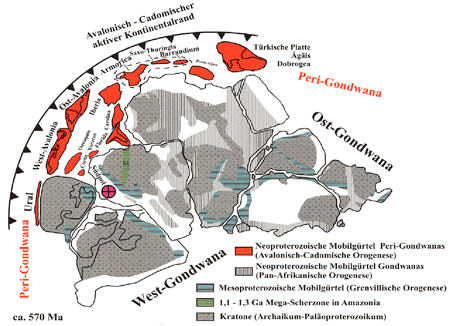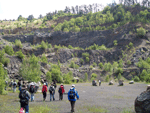Summer School 2010
This topic was of interest to the FG-members because it illustrated the paleobiological, biostratigraphic and ecological development following the base-Cambrian metazoan radiation. Specifically, we studied the Lower Paleozoic strata west of Prague, capital of Czechia, the so-called Barrandian of regional literature.
The Barrandian represents a large and prominent synclinorium within the Bohemian Massif, which is world-famous for its nearly complete sequence of low-grade metamorphic, early Palaeozoic (Cambrian – Middle Devonian) shelf-facies sedimentary rocks. This synclinorium is embedded in a major fold belt of late Paleozoic age, part of the Variscan Orogeny of Central Europe. For almost 200 years, this region has been a reference area for palaeobiological research on the early Palaeozoic, particularly the Middle Cambrian, Silurian, and Lower Devonian. The region houses the Silurian-Devonian boundary stratotype at Klonk as well as the international stratotypes for the Pridolian (Upper Silurian), the Lochkovian and the Pragian (Lower Devonian) stages. The Barrandian was named for the brilliant engineer, geologist and palaeontologist Joachim Barrande (1799-1883) who devoted most of his live to the research of the Palaeozoic of the Prague Basin.

Fig 1. - Generalized geologic map of the "Barrandian" region, a synclinorium of well preserved Lower Paleozoic strata southwest of Prague, the Czech capital.
The field trip and workshop focused on the stratigraphy and biostratigraphy of the Early Palaeozoic, the exceptional fossil Lagerstätten of the region (Middle Cambrian fauna of Jince and Skryje subbasins, Silurian/ Devonian faunas, Devonian Koneprusy reef complex) and their biogeographic and palaeogeographic implications.
Because most of us had worked on the Ediacaran side of the Precambrian-Cambrian boundary, this workshop served well to take a comprehensive look "at the other side" of this stratigraphic boundary. In addition, the Barrandian succession shows a famous Paleozoic succession with increasing complexity of the ecology. These strata are, similar to the Chinese Paleozoic exposures of peri-Gondwana affinity but show a different climatic regime.

Fig. 2: Tectonic reconstruction of West-Gondwana with an emphasis of peri-Gondwana cratons (red). Chinese microcontinents (Yangtze, Tarim, Yili) were located further east but also formed the margin of Gondwana.
In order to familiarize our visitors with European culture and history, we framed the field excursions with a visit to the ancient city of Görlitz and Freiberg in southeastern Germany, prior to travelling to Prague on June 12. In Prague, a city tour was not to be missed. Back in Berlin, our group took a half-day trip to Potsdam and Sanssouci Castle.
 |
 |
 |
Fig. 3: Beautiful city streets in Görlitz (left) and Prague (right); view from Charles Bridge in Pague (center).
Seven days in Czechia followed of which we spent six days in the field, studying outcrop sections, collecting fossils, and discussing the ecology with our Czech guides. We began with the Cambrian conglomerates in Pribram and the Lower Cambrian Paseky Shale (June 13), continued with the Middle Cambrian of the Jince- Pribram Region (June 15), examined the Precambrian to Middle Cambrian of the Skryje-Tyrovice Region (June 16) and the Ordovician of the Barrandian (June 17).

Fig. 4: Dr. Oldrich Fatka from Charles University led us for six of the seven days through the Barrandium, giving freely of his time and expertise.
The two final days of the field work were dedicated to the Silurian Motol Fm. (Wenlockian) and the outcrops at the Kosov Quarry (June 18) and to the Devonian, exposed at the Budnany cliff in Karlstejn and in reefal facies at the Koneprusy limestone (June 19).
 |
 |
 |
Fig. 5: Field workshop participants at the Middle Cambrian of Skryje-Luh (left), the Kosov Quarry (Silurian, center) and the Budnany cliff in Karlstejn with the Silurian – Devonian parastratotype section (Pridoli – Lochkov Fm.).
Our field workshop was interrupted by a one-day symposium at the Geological Institute of Charles University in Prague, where the German and Chinese groups reported their progress to each other via a series of 19 (densely spaced!) prepared scientific talks by scientists and students from both groups. Also, we visited the excellent museum of the Department.
 |
 |
 |
Fig. 6: Workshop participants examining thin section in Freiberg (left), at the SEM in Berlin (center), and attending the symposium in Prague (right).
After travelling back, the workshop continued with a four-day stay in Berlin which consisted of a mix of visits to museums, research laboratories, and individual research activities with group members.
 |
 |
 |
Fig. 7: Minerals on display in Freiberg (left); famous Lower Paleozoic invertebnrate fossils at the National Museum in Prague (center), and part of the ammonite collection of the Paleontology Section of the FU Berlin Geology department.
photo credit this page: Christoph Heubeck